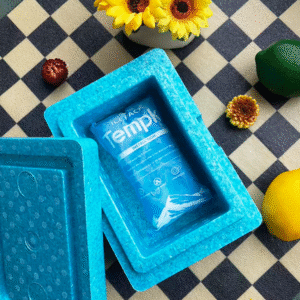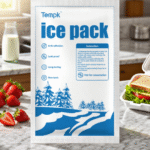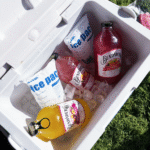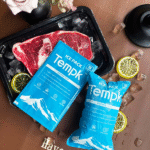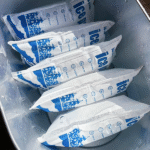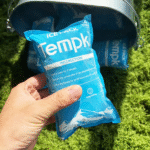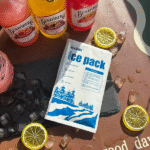Packs de glace carbonique pharmaceutique: Guide essentiel pour 2025 Logistique de la chaîne du froid
Expédition de produits pharmaceutiques, médicaments particulièrement sensibles à la température, nécessite un contrôle strict de la température pour garantir son efficacité. Packs de glace sèche pharmaceutique fournir une solution fiable pour maintenir ces températures, s'assurer que les médicaments, vaccins, et les produits biologiques restent sûrs tout au long de leur voyage. Ce guide explorera l'importance des blocs de glace carbonique dans la logistique pharmaceutique, comment les utiliser de manière optimale, et les tendances qui façonnent l'expédition de médicaments sensibles à la température dans 2025.
-
Pourquoi les blocs de glace carbonique pharmaceutiques sont essentiels pour un transport de médicaments en toute sécurité.
-
Comment choisir le bon sac de glace carbonique basé sur des produits pharmaceutiques spécifiques.
-
Les avantages de la glace carbonique par rapport aux autres méthodes de refroidissement dans l'industrie pharmaceutique.
-
Meilleures pratiques pour utiliser de la neige carbonique pour conserver les médicaments sensibles à la température pendant le transport.
Pourquoi les packs de glace carbonique pharmaceutique sont-ils importants pour une expédition sûre des médicaments?
Les blocs de glace carbonique pharmaceutiques sont essentiels pour maintenir les températures ultra-basses requises par les produits médicaux sensibles tels que les vaccins., biologique, et enzymes. La glace carbonique se sublime directement d'un solide à un gaz, ce qui permet de maintenir une température constante sans risque de fuite d'eau ou de contamination du produit. Cela fait de la glace carbonique un élément essentiel pour garantir que les produits pharmaceutiques restent dans les plages de température requises., réduisant le risque de détérioration ou de perte d'efficacité pendant le transport.
Avantages des packs de glace carbonique pharmaceutique
-
Durée de refroidissement plus longue: La glace carbonique peut maintenir des températures aussi basses que -78,5°C pendant plusieurs jours, ce qui le rend idéal pour les expéditions nécessitant des températures aussi basses que -20°C à -70°C.
-
Aucun risque de dégât des eaux: Contrairement à la glace traditionnelle, la neige carbonique se sublime en gaz, ne laissant aucune eau liquide qui pourrait endommager les produits ou les emballages.
-
Contrôle précis de la température: La glace carbonique assure un effet de refroidissement constant, crucial pour maintenir l’intégrité des produits médicaux sensibles à la température sur de longues distances et durées.
Comment choisir le bon pack de glace carbonique pharmaceutique
La sélection du sac de glace carbonique approprié dépend de plusieurs facteurs clés, comme les exigences de température du produit, la durée de l'expédition, et la taille de l'envoi. Voici comment garantir une utilisation optimale de la glace carbonique:
Considérations clés pour la sélection de glace carbonique
-
Exigences de température du produit: Les vaccins et les produits biologiques doivent souvent être conservés à des températures ultra-basses. La glace carbonique est idéale pour répondre à ces exigences strictes, maintenir les produits à la bonne température pendant de longues périodes.
-
Durée de l'expédition: La quantité de neige carbonique nécessaire augmente avec la durée du transport. Par exemple, un envoi sous 72 heures peut nécessiter plus de glace carbonique qu'un envoi sous 24 heures. Il est essentiel de calculer les besoins en neige carbonique en fonction du délai d'expédition.
-
Taille et poids de l'emballage: Les expéditions plus importantes nécessitent plus de neige carbonique pour maintenir le contrôle de la température, surtout lors de l'expédition de grandes quantités.
Exemple: Exigences en matière de glace carbonique basées sur le produit et la durée
| Produit pharmaceutique | Glace carbonique nécessaire (par 24 heures) | Plage de température | Durée d'expédition |
|---|---|---|---|
| Vaccins | 1-2 lbs | -20° C à -70 ° C | 24-72 heures |
| Biologique | 3-5 lbs | -20° C à -50 ° C | 24-72 heures |
| Médicaments sensibles à la température | 2-3 lbs | -10° C à -20 ° C | 24-48 heures |
| Échantillons d'enzymes | 4-6 lbs | -20°C à -60°C | 48-72 heures |
Avantages de l'utilisation de la glace carbonique par rapport à d'autres méthodes de refroidissement
Effet rafraîchissant plus durable
La capacité de la glace carbonique à maintenir des températures inférieures à zéro pendant des jours en fait une option supérieure à la glace traditionnelle., qui peut fondre rapidement et ne pas maintenir la chaîne du froid nécessaire.
Aucun risque de dégât des eaux
Glace traditionnelle, une fois qu'il fond, produit de l'eau qui pourrait s'infiltrer dans les emballages et potentiellement endommager les produits médicaux. Glace sèche, cependant, sublimer directement dans le gaz, éliminer le risque de dégâts des eaux.
Idéal pour le contrôle des températures ultra-basses
La glace carbonique est particulièrement efficace pour les produits pharmaceutiques nécessitant des températures ultra-basses, comme les vaccins à ARNm. Il maintient des conditions de froid constantes tout au long des expéditions longue distance et sur plusieurs jours.
Cas réel: Une société pharmaceutique expédiant des vaccins dans le monde entier a signalé que la neige carbonique permettait un contrôle fiable de la température des vaccins. 72 heures, alors que l'utilisation de glace ordinaire entraînait des fluctuations de température qui compromettaient la qualité du vaccin.
Meilleures pratiques d’utilisation des blocs de glace carbonique pharmaceutiques
Emballage approprié
Choisissez un emballage isotherme qui permet de ralentir la sublimation de la neige carbonique. Les conteneurs isolés sous vide sont idéaux pour les expéditions longue distance car ils offrent une rétention supérieure de la température., tandis que les conteneurs en mousse suffisent pour des expéditions plus courtes.
Superposition efficace de glace sèche
Placez de la neige carbonique au fond du récipient pour garantir que l'air froid circule naturellement vers le bas.. Assurez-vous qu'il y a suffisamment d'espace pour que le gaz CO₂ puisse s'échapper., car le processus de sublimation peut provoquer une accumulation de pression s'il n'est pas correctement ventilé.
Systèmes de surveillance de la température
Utiliser des systèmes de surveillance de la température en temps réel, tels que les capteurs compatibles IoT, pour suivre la température des expéditions pharmaceutiques pendant le transit. Ces dispositifs garantissent que le produit reste dans la plage de température souhaitée, assurer la tranquillité d’esprit et réduire les risques.
2025 Tendances de la logistique de la chaîne du froid pharmaceutique
Dans 2025, les progrès technologiques façonnent l’avenir de la logistique de la chaîne du froid pharmaceutique. Voici quelques tendances notables:
Solutions d'emballage intelligents
Les emballages intelligents équipés de capteurs IoT gagnent en popularité. Ces capteurs surveillent la température, humidité, et localisation en temps réel, garantir que les produits pharmaceutiques sensibles à la température soient conservés dans des conditions optimales tout au long du transit.
Pratiques d'expédition durables
À mesure que les préoccupations environnementales augmentent, l'industrie de la logistique pharmaceutique se tourne vers des solutions plus respectueuses de l'environnement. Il s'agit notamment d'emballages biodégradables et d'innovations visant à réduire l'empreinte carbone des opérations de la chaîne du froid..
Insistance au marché
Par 2025, le marché de la logistique de la chaîne du froid pharmaceutique devrait dépasser $120 milliard. Cette croissance est due à la demande croissante de médicaments sensibles à la température et à l'utilisation généralisée de neige carbonique pour les expéditions pharmaceutiques..
Questions fréquemment posées (FAQ)
Quelle quantité de neige carbonique est nécessaire pour expédier des produits pharmaceutiques?
La quantité de neige carbonique dépend du produit, durée d'expédition, et les exigences de température. En général, 1-2 livres de glace carbonique par 24 les heures sont suffisantes pour la plupart des expéditions pharmaceutiques.
La glace carbonique peut-elle être utilisée pour expédier des médicaments sensibles à la température?
Oui, la glace carbonique est idéale pour expédier des médicaments sensibles à la température qui doivent rester dans une plage de température spécifique. Il garantit que les produits restent froids sans risque de fuite d'eau.
Conclusion et recommandations
Les blocs de glace carbonique pharmaceutiques sont essentiels pour l'expédition en toute sécurité de médicaments sensibles à la température.. En comprenant les meilleures pratiques d’utilisation de la neige carbonique, choisir le bon emballage, et suivre les dernières tendances en matière de logistique, les sociétés pharmaceutiques peuvent garantir l’intégrité de leurs produits pendant le transport.
Conseils exploitables:
-
Calculer la glace carbonique nécessaire en fonction de la durée d'expédition et des besoins du produit.
-
Assurer une manipulation et une ventilation appropriées de la glace carbonique pour éviter les risques pour la sécurité.
-
Restez informé des dernières tendances en matière de logistique durable de la chaîne du froid.
À propos du tempk
Et tempk, nous sommes spécialisés dans la fourniture de solutions innovantes de chaîne du froid adaptées à l'industrie pharmaceutique. Nos sacs à glace sec, systèmes de surveillance de la température, et des technologies d'emballage avancées garantissent que vos produits pharmaceutiques sensibles sont transportés de manière sûre et efficace.. Contactez-nous pour une consultation afin d’optimiser vos opérations de chaîne du froid.
Étapes suivantes: Contactez Tempk pour obtenir des conseils d'experts sur l'optimisation de l'expédition de produits pharmaceutiques ou pour en savoir plus sur nos solutions d'expédition durables..






